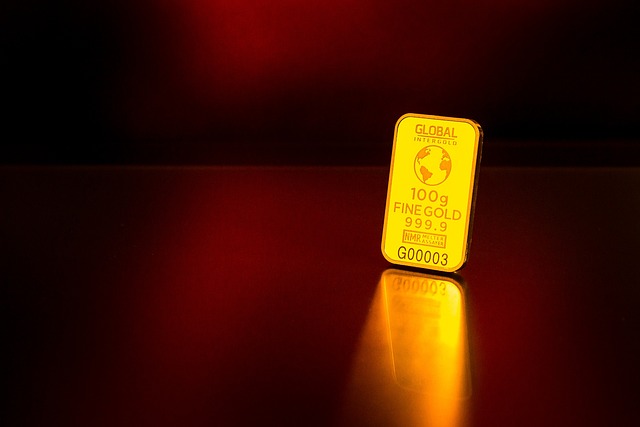Investing in gold through a Roth IRA involves setting up a self-directed IRA account with a custodian experienced in alternative assets like gold. This allows for the purchase of physical gold, coins, and bullion that comply with IRS standards for purity. The process requires careful selection of a reliable custodian firm to ensure the investment's tax-advantaged status within the Roth IRA framework. Investors must work with reputable precious metals dealers to acquire eligible gold products, which are then stored in an IRS-approved depository. All transactions must be conducted in accordance with IRS regulations, and a trustee knowledgeable in managing such assets is essential for navigating the complexities of holding physical precious metals within an IRA. A rollover from an existing Roth IRA to a self-directed account specifically set up for gold investments ensures compliance with tax laws, allowing investors to diversify their retirement portfolios with tangible assets while preserving the Roth IRA's benefits.
Exploring the transformative journey of converting a Roth IRA into gold investments, this article elucidates the process step-by-step. Initially, one must set up a self-directed Roth IRA that sanctions investment in tangible assets like gold and other precious metals, offering a diversification beyond the conventional stock and bond market. Subsequent sections delve into adhering to IRS guidelines, selecting an expert trustee in precious metals, procurement of qualified physical gold, and executing a rollover to transfer existing retirement funds—ensuring a robust financial strategy with a golden edge.
- Establishing a Self-Directed Roth IRA for Gold Investments
- Compliance with IRS Regulations for Roth IRA Conversion
- Selecting a Trustee Specializing in Precious Metals for Your IRA
- Purchasing Qualified Physical Gold for Your Roth IRA
- Navigating the Rollover Process to Transfer Existing Retirement Funds
Establishing a Self-Directed Roth IRA for Gold Investments

To begin the process of investing in gold through a Roth IRA, individuals must first open a self-directed Roth IRA account. This unique type of IRA differs from traditional accounts as it offers the capability to hold a variety of assets, including physical gold, coins, and bullion that meet the standards set by the Internal Revenue Service (IRS). The establishment of such an account is initiated by selecting a custodian firm specializing in self-directed IRAs. This custodian is responsible for holding the assets within the IRA and ensuring they comply with IRS regulations. It’s crucial to conduct thorough research to identify a reputable custodian with experience in alternative assets, as their role is pivotal in facilitating the acquisition of precious metals within the tax-advantaged framework of a Roth IRA.
Once a self-directed Roth IRA account is established and a custodian is selected, investors can proceed to allocate funds to acquire gold. The custodian will provide guidelines on which types of gold investments are permissible within the IRA, typically adhering to the IRS’s purity standards for coins and bullion. Investors then work with precious metals dealers to purchase qualifying gold products, ensuring that all transactions are completed in the name of the self-directed Roth IRA to maintain compliance with IRS rules. This careful selection process ensures that the investment is both compliant and structured to potentially benefit from the tax advantages associated with a Roth IRA, making it a strategic choice for those interested in gold as part of their retirement portfolio.
Compliance with IRS Regulations for Roth IRA Conversion

When considering the conversion of a Roth IRA to gold, adherence to Internal Revenue Service (IRS) regulations is paramount. The IRS stipulates that any investment within a Roth IRA, including precious metals, must be held by a trustee that is IRS-approved and compliant with the rules governing self-directed IRAs. The conversion process itself is straightforward: you roll over funds from an existing Roth IRA into a new self-directed Roth IRA account that specializes in alternative assets such as gold. This rollover must adhere to specific IRS guidelines to maintain the tax-advantaged status of the Roth IRA.
The physical gold held within the Roth IRA must meet the purity and fineness requirements set by the IRS, which typically mandate that the gold be at least 99.9% pure. Additionally, the gold must be stored with a custodian approved by the IRS to hold such assets for retirement accounts. This custodian is responsible for ensuring that all transactions and storage facilities comply with IRS regulations, thus safeguarding your investment from any inadvertent tax implications or penalties. It’s essential to engage with reputable custodians and dealers who are well-versed in these rules to ensure a compliant and successful conversion of your Roth IRA to gold.
Selecting a Trustee Specializing in Precious Metals for Your IRA

When considering the conversion of your Roth IRA to gold or other precious metals, selecting a trustee with expertise in these assets is paramount. The trustee you choose will play a crucial role in the management and handling of your investment within the IRA framework. It’s essential to opt for a trustee who specializes in precious metals as they will have the necessary knowledge and resources to facilitate this unique type of investment. These specialists understand the intricacies involved with holding physical gold or other precious metals within an IRA, including compliance with IRS regulations. They can provide guidance on the types of metals eligible for IRA investment, storage requirements, and the logistics of purchasing and transferring these assets without disrupting your tax-advantaged status.
Upon selecting a trustee who specializes in precious metals, you’ll need to work closely with them to establish your self-directed Roth IRA. This will involve setting up an account that specifically allows for the investment in physical gold and other IRS-approved precious metals. Your trustee will assist you in navigating the initial steps, from selecting a custodian who is experienced in holding these types of assets to ensuring that your investments align with the purview of the IRA. The process continues with identifying a reputable dealer from whom to purchase your gold, verifying the metals’ purity and compliance with IRS standards, and arranging for secure storage of your investment. Throughout this process, your trustee will be an invaluable resource, ensuring that each transaction is executed within the confines of the law and in a manner that safeguards the integrity of your retirement savings.
Purchasing Qualified Physical Gold for Your Roth IRA

To purchase qualified physical gold for your Roth IRA, it is imperative to align with the Internal Revenue Service (IRS) guidelines that define what constitutes ‘qualified physical gold.’ Typically, this includes gold bullion and coins that meet specific fineness or purity standards. The first step in the process is to select a reputable custodian that specializes in self-directed IRAs and has approval to store precious metals. This custodian will facilitate the transaction and ensure that the gold you invest in adheres to IRS regulations. Once you have established your account with such a custodian, you can proceed to make a purchase.
The custodian will connect you with a reputable dealer from whom you can buy the physical gold. It is crucial to conduct due diligence on the dealer to ensure they are trusted and adhere to industry standards. After selecting your desired gold products, your dealer will arrange for the metal to be shipped to and stored at an IRS-approved depository linked to your self-directed Roth IRA. The depository will safeguard your investment, provide insurance coverage, and conduct regular audits, ensuring that your gold holds its value and remains a valid asset within your retirement portfolio. This process secures your investment’s future while allowing you the unique opportunity to diversify your holdings with a tangible asset in the form of physical gold.
Navigating the Rollover Process to Transfer Existing Retirement Funds

To initiate the conversion of your Roth IRA to gold, a critical step is to navigate the rollover process for transferring existing retirement funds. This involves several precise actions to ensure a seamless transition without incurring unwanted taxes or penalties. The process commences with identifying a trustworthy custodian who specializes in self-directed IRAs and is authorized to hold physical gold and precious metals. Once you have selected a custodian, they will guide you through the rollover procedure, which typically starts with requesting a distribution from your current Roth IRA provider. Ensure that this distribution is directly transferred to the new custodian established for your self-directed Roth IRA. The funds must be deposited into the custodian’s bank account and not commingled with personal funds to maintain the tax-advantaged status of your IRA. After the funds are received by the new custodian, they will purchase the allocated physical gold or precious metals on your behalf, according to the IRS-approved purity standards for retirement accounts. It is imperative to collaborate closely with both the custodian and a knowledgeable financial advisor throughout this process to ensure compliance with all IRS rules and regulations regarding the transfer and investment of precious metals in an IRA. This diligence safeguards your investment and preserves the tax benefits associated with your Roth IRA.
In conclusion, transitioning a traditional Roth IRA into a gold-backed investment is a well-defined process that offers investors a unique opportunity to diversify their retirement portfolios. By setting up a self-directed Roth IRA with a focus on precious metals, individuals can comply with IRS guidelines while exploring alternative assets like physical gold. Careful selection of a trustee with expertise in this niche is crucial, as is adherence to the regulations governing Roth IRA conversions. The process of purchasing qualified physical gold within the IRA framework and executing a rollover from existing retirement accounts is designed to be transparent and straightforward. This move can potentially provide a hedge against inflation and currency devaluation, offering a tangible asset as part of a balanced investment strategy for the future.
